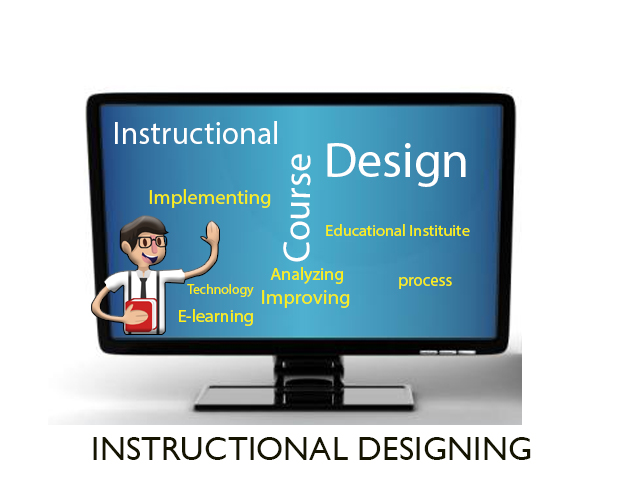Teaching is one of the noblest professions. Here you are not just imparting knowledge but also molding the cognitive ability in the mind of learners. A good teacher imparts the fortune of knowledge for the youth to thrive. The progress depends upon the quality of syllabus being taught. Each student has his own ability to understand. The outcome of learning indicates the standard of teaching demonstrated. The expansion of learning and teaching no knew bounds in the 21st century. Digitalization is curbing the illiteracy rate. Each step in the professional ladder requires skill development. This where a proper education system comes to play. Teachers or instructors need to deliver the subject in way to develop the critical thinking no matter how different each student is.
Instructional design (ID),is also known as instructional systems design (ISD) or recently as learning experience design (LXD).It is the practice of systematically designing, developing and delivering instructional products and experiences, both digital and physical, in a consistent and reliable fashion toward an efficient, effective, appealing, engaging and inspiring acquisition of knowledge.
Instructional design is embedded in developing learning methodology paired with human psychology:
- Cognitive thinking
- Behavioral psychology
- Constructive and critical thinking.
Above all instructional design has emerged in accordance with the human psychology to get attracted to the power of “look, feel and memorize”. Instructional design started developing since WWII when instructions and training evolved through analyze, design and evaluation procedure. The whole idea of instructions took the form in context with the psychological approach of human mind. The evolution of instructional design started from military training to educational field and industrial training.
Commonly used Models of Instructional Designs
- ADDIE Model.
- Merrill’s Principles of Instruction.
- Gagne’s Nine Events of Instructions.
- Bloom’s Taxonomy.
ADDIE Model
ADDIE stands for Analyze, Design, Develop, Implement, and Evaluate. These 5 phase process complement each other and bring out best of the instructional designs.
1) Analyze:
This phase is finding out the whole purpose of the syllabus. It is picking up the right pieces of the puzzle.
- Identifying the audience
- Purpose of the training
- Determining the field of instructional environment
- Conceptualizing pre-existing knowledge and skills
- Appraise the opportunities and obstructions.
2) Design :
In this phase the designer starts to emphasize in attaining the learning objectives. Story boards are created and plans accordingly the designs :
- looks
- Feel
- Operation methods
- Mode of delivery.
3 ) Develop:
Now all the puzzles are brought together in this phase and the designer will :
- Assemble the contents.
- Incorporate the contents into the design.
- Create Instructional Design.
4) Implement:
The course is imparted to the students in the form of carefully designed instructions in the form of
- Presentations
- Job aids
- Participant guides
- Technical Terminology
5) Evaluate: The instructional designer uses various methods to determine whether the teaching methodology is giving the expected results.
- Formative assessment.
- Summative assessment.
Merrill’s Principles of Instruction
Merrill’s Principles of Instruction were founded by M. David Merrill, a noted educational researcher and teacher. There are five core principles that center on task-based learning and problem -solving.
- Learners are engaged in solving real-world
- Existing knowledge is activated as a foundation for new knowledge.
- New knowledge is demonstrated to the learner.
- Learners apply new knowledge.
- New knowledge is integrated into the learner’s world.
1) Education is promoted when learners are engaged in solving real-world problems –
- Show Provide a work example of the task and the learners will complete.
- Ensure learners are engaged at the problem and task levels, as well as the operation or action level.
- learners develop a deeper understanding of key concepts while strengthening problem solving skills such as analytical thinking, initiative and creativity.
2) Activation:
Learning is promoted when existing knowledge is activated as a foundation for new knowledge.
- Upgrade previous skill or experiences.
- Instill engaging and authentic tasks
- Problem hierarchy from basic to complex level is instituted.
3)Demonstration :
Learning is promoted when new knowledge is demonstrated to the learner. It helps them to identify areas of improvement. New knowledge is demonstrated to the learner in the form of various modes of teaching :
- E-Learning videos.
- online training tutorials.
- image-rich info-graphics.
4)Application :
The value of learning is assessed when leaners apply the new knowledge .
- Align practice activities with learning outcomes
- Gradually withdraw coaching to build learner independence
- Provide opportunities to learners to apply their learning to different perspectives.
5) Integration:
Learning is promoted when new knowledge is integrated into the learner’s world.
- Provide opportunities for learners to demonstrate and share their learning .
- Include reflection activities to recognize progress.
- Encourage learners to transfer their learning to their own life.
Merrill’s Principles help to ensure that your instructions are efficient and effective.
Gagne’s Nine Events of Instructions
In 1965, Robert Gagne proposed a series of events that are associated with and address the mental conditions for learning. Gagne’s nine events of instruction can help you build a framework to prepare and deliver instructional content while considering and addressing conditions for learning. Each of the nine events of instruction is highlighted below :
- Gain attention of the students.
- Inform students of the objectives.
- Stimulate recall of prior learning.
- Present the content.
- Provide learning guidance.
- Elicit performance (practice) .
- Provide feedback.
- Assess performance.
Bloom’s Taxonomy
Benjamin Bloom in 1956, published as a kind of classification of learning outcomes .Bloom’s taxonomy is a set of three hierarchical models used to classify educational learning objectives into levels of complexity and specificity. Bloom’s Taxonomy was created by The three lists cover the learning objectives in:
- Cognitive- Knowledge based
- Affective – Emotion based
- Sensory Domains – Action based
The framework elaborated by Bloom and his collaborators consisted of six major categories – Knowledge, Comprehension, Application, Analysis, Synthesis, and Evaluation. This model aims at elaborating the purpose and value of teaching methodologies.
Top Ten skills of Instructional designers :
- Deep Level Of Understanding Of Learning Models – Many recruiters focus on the candidates with good knowledge of models of Instructional Designs like ADDIE and Bloom’s Learning Taxonomy .There are various Institutes offering courses in Instructional Designing . Certificate courses will give more skills and enhance chances in the job market
- Learning Technology Experience : An instructor should be updated with latest technologies and software .It is essential to have the ability to create, develop, manipulate, and share learning content using various technologies.
3. Presentation Technology Knowledge
In addition to the normal creation of learning modules, learning instructors are often tasked with developing videos, live training sessions, webinars, and more. Therefore, having the ability to whiteboard ideas for learning materials and develop presentation slides and handouts combined with serious design and script writing/video production chops can take a candidate far.
4. Project Management Skills
Every learning management professional will be asked to head up some, if not all, of the project management aspects of course development. Staying mindful of stakeholder objectives is a part of all projects. This requires strong interpersonal skills, organizational ability, and a deadline-driven focus. Develop project management skills by taking on new projects and using PM software to manage steps, processes, and resources.
5. Visual And Artistic Talents
Nearly every job posting for eLearning professionals and Instructional Designers I see include the critical skills of knowing how to use Articulate, Canva, Photoshop, Illustrator, Dreamweaver, WordPress, and other visual design tools. Storyboarding, creating imagery out of ideas, and presenting facts in an interesting way requires a level of artistry that few possess.
6. Assessment Development
All learning design candidates need to know how to create powerful assessment elements to accompany courses. Organizations use this information to measure the success or failure of new courses. In many cases, the ability to align assessments with company objectives is a talent that few Learning and Development pros can pull off.
7. Understanding Of Virtual Reality
An emerging area in learning is the use of virtual reality (VR) tools and applications that immerse learners in real-world simulations. As we move more into this realm of learning in the mainstream, Instructional Designers must be able to understand how to apply VR to learning content and collaborate with visual designers.
8. Above Average Communication
All Instructional Designers need to possess superior communication skills in every aspect. A great deal of the time, Learning and Development pros must be able to communicate complex topics in terms that others can understand. This includes the use of communication platforms for creating and distributing content.
9. Passion For Knowledge
Instructional Designers are expected to be lifelong learners, with a demonstrable passion for learning and teaching others. They must be interdisciplinary focused and experts in their field of interest. Most off all, they must remain focused on the outcome of learners, and continually set the bar high for themselves and others. Many Instructional Design professionals are published authors, speakers, and industry leaders because they have this drive.
10. Proactive Career Growth
Top candidates in learning and design know that they are only at their best when they are advancing in their own careers. This requires always learning to do things better and more efficiently. Instructional Design candidates need to be mindful of their performance metrics to measure their own success.
This is not an inclusive list of the skills that learning and design candidates need to have — there are merits to other traits such as creativity, the ability to work as part of a team, and leadership skills. In order to land a job as an Instructional Designer, make sure you can confidently demonstrate most of the above skills through current and past work history.






I first struggled to locate the solutions to problems because I wasn’t sure where to look. However, I feel at ease when I visit this blog because their notes are so beneficial to me. We appreciate you sharing this fantastic instructional design course with us.
The course’s coverage is thorough and meets my needs. The instructors are committed and educated! We appreciate you reading our fantastic blog at Instructional Designs. It will help us to handle a range of situations with more tact and to be more cautious when making comments and dealing with subordinates.
Excellent resource for those looking to learn about instructional design. The courses offered provide a comprehensive overview of the subject and its various applications.
The instructional design courses offered are taught by experienced professionals, ensuring that students receive a quality education. Highly recommended.
The online format of these instructional design courses makes them accessible and convenient for students who have busy schedules. A great investment.